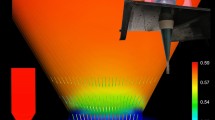Abstract
This paper contains results of numerical modelling of the onset of silo flow for granular material in a model silo with convergent walls. The calculations were performed with a finite element method based on a polar elasto-plastic constitutive relation by Mühlhaus. It differs from the conventional theory of plasticity by the presence of Cosserat rotations and couple stresses using a mean grain diameter as a characteristic length. The characteristic length causes that numerical results do not depend upon the mesh discretisation. The model tests on rapid silo flow of glass beads performed by Renner in a glass hopper with a large wall inclination from the bottom were numerically simulated. The FE-calculations were performed for plane strain by taking into account inertial forces and linear viscous damping. A satisfactory agreement between numerical and experimental results was obtained. In addition, the FE-calculations were performed for very rough walls. Advantages and limitations of a continuum approach for simulations of rapid silo flow were outlined.
Similar content being viewed by others
Author information
Authors and Affiliations
Additional information
Received: 10 February 2001
Rights and permissions
About this article
Cite this article
Tejchman, J., Klisiński, M. FE-studies on rapid flow of bulk solids in silos. Gran Matt 3, 215–230 (2001). https://doi.org/10.1007/PL00010917
Issue Date:
DOI: https://doi.org/10.1007/PL00010917




